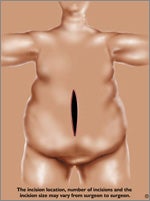
For the last decade, laparoscopic procedures have been used in a variety of general surgeries. Many people mistakenly believe that these techniques are still "experimental." In fact, laparoscopy has become the predominant technique in some areas of surgery and has been used for weight loss surgery for the past 6 years at Boston Medical Center.
When a laparoscopic operation is performed, a small video camera is inserted into the abdomen. The surgeon views the procedure on a separate video monitor. Most laparoscopic surgeons believe this gives them better visualization and access to key anatomical structures.

The camera and surgical instruments are inserted through small incisions made in the abdominal wall. This approach is considered less invasive because it replaces the need for one long incision to open the abdomen. A recent study shows that patients having had laparoscopic weight loss surgery experience less pain after surgery resulting in easier breathing and lung function and higher overall oxygen levels. Other realized benefits with laparoscopy have been fewer wound complications such as infection or hernia, and patients returning more quickly to pre-surgical levels of activity.
Laparoscopic procedures for weight loss surgery employ the same principles as their "open" counterparts and produce similar excess weight loss. Not all patients are candidates for this approach, just as all bariatric surgeons are not trained in the advanced techniques required to perform this less invasive method. The American Society for Bariatric Surgery recommends that laparoscopic weight loss surgery should only be performed by surgeons who are experienced in both laparoscopic and open bariatric procedures.
 en
en 
 Français
Français Deutsch
Deutsch Italiano
Italiano Español
Español Tiếng Việt
Tiếng Việt Kreyol ayisyen
Kreyol ayisyen